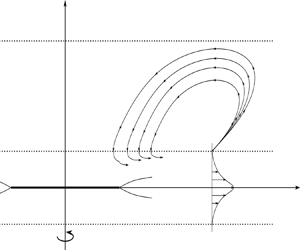Published online by Cambridge University Press: 18 March 2021

We consider the motion at large Reynolds number of an incompressible fluid around a thin circular disk of finite radius rotating in its plane. The disk is placed in a large tank filled with an initially stagnant fluid. Then it is brought into rotation about its centre with constant angular velocity. Due to viscosity, a layer of fluid adjacent to the disk gets involved in the circumferential motion. This activates centrifugal forces; the fluid particles start to deviate in the radial direction. When they cross the edge of the disk, a thin jet is formed. Firstly, we solve the classical boundary-layer equations for the flow in the boundary layer in the direct neighbourhood of the disk surface and in the jet. The solution is found to develop a discontinuity at the ‘head’ of the jet where the radial and circumferential velocity components experience a jump. This type of discontinuity, called a pseudo-shock, was previously observed by Ruban & Vonatsos (J. Fluid Mech., vol. 614, 2008, pp. 407–424). Then, we investigate the internal structure of the pseudo-shock. We find that the fluid motion is described by the Euler equations in the leading-order approximation. Their solution shows that, as the jet penetrates the stagnant fluid, it ejects the fluid from the boundary layer into the surrounding area. Analysis of the inviscid region outside the boundary layer reveals that the ejected fluid returns back to the boundary layer through the ‘entrainment process’. Finally, we conclude this paper with the study of the wake in the vicinity of the disk rim.